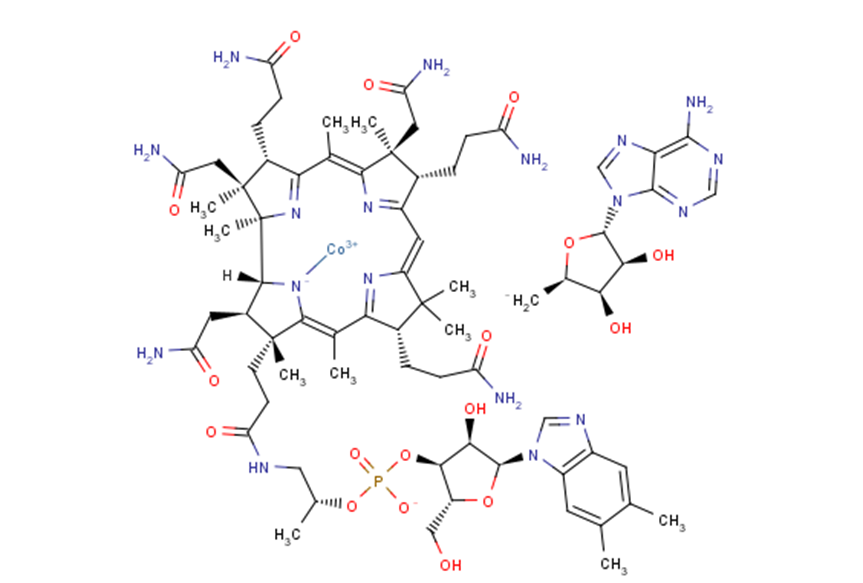
Adenosylcobalamin
CAS No. 13870-90-1
Adenosylcobalamin( Coenzyme B12,Cobamamide,AdoCbl )
Catalog No. M22704 CAS No. 13870-90-1
Adenosylcobalamin is a biologically active form of vitamin B12 .It is a cofactor for methylmalonyl CoA mutase.?It belongs to the corrinoid group of compounds, which contain a corrin macrocycle, and is produced only by certain bacteria and archaea.?
Purity : >98% (HPLC)
 COA
COA
 Datasheet
Datasheet
 HNMR
HNMR
 HPLC
HPLC
 MSDS
MSDS
 Handing Instructions
Handing Instructions
| Size | Price / USD | Stock | Quantity |
| 25MG | 37 | In Stock |


|
| 100MG | 67 | In Stock |


|
| 200MG | Get Quote | In Stock |


|
| 500MG | Get Quote | In Stock |


|
| 1G | Get Quote | In Stock |


|
Biological Information
-
Product NameAdenosylcobalamin
-
NoteResearch use only, not for human use.
-
Brief DescriptionAdenosylcobalamin is a biologically active form of vitamin B12 .It is a cofactor for methylmalonyl CoA mutase.?It belongs to the corrinoid group of compounds, which contain a corrin macrocycle, and is produced only by certain bacteria and archaea.?
-
DescriptionAdenosylcobalamin is a biologically active form of vitamin B12 .It is a cofactor for methylmalonyl CoA mutase.?It belongs to the corrinoid group of compounds, which contain a corrin macrocycle, and is produced only by certain bacteria and archaea.?It is a cofactor for various enzymes including mutases, eliminases, aminomutases, and a reductase.Adenosylcobalamin serves as the cofactor for a group of enzymes that catalyze unusual rearrangement or elimination reactions.(In Vitro):Adenosylcobalamin serves as the cofactor for a group of enzymes that catalyze unusual rearrangement or elimination reactions.
-
In VitroAdenosylcobalamin serves as the cofactor for a group of enzymes that catalyze unusual rearrangement or elimination reactions.
-
In Vivo——
-
SynonymsCoenzyme B12,Cobamamide,AdoCbl
-
PathwayProteasome/Ubiquitin
-
TargetEndogenous Metabolite
-
RecptorHuman Endogenous Metabolite
-
Research Area——
-
Indication——
Chemical Information
-
CAS Number13870-90-1
-
Formula Weight1578.57
-
Molecular FormulaC72H99CoN18O17P
-
Purity>98% (HPLC)
-
SolubilityH2O:4 mg/mL(2.53 mM)
-
SMILES[CH2-][C@H]1O[C@@H]([C@@H](O)[C@H]1O)n1cnc2c(N)ncnc12.[H][C@]12[C@H](CC(N)=O)[C@@](C)(CCC(=O)NC[C@@H](C)OP([O-])(=O)O[C@@H]3[C@@H](CO)O[C@@H]([C@@H]3O)n3cnc4cc(C)c(C)cc34)\C([N-]1[Co+3])=C(C)\C1=N\C(=C/C3=N/C(=C(C)\C4=N[C@]2(C)[C@@](C)(CC(N)=O)[C@@H]4CCC(N)=O)[C@@](C)(CC(N)=O)[C@@H]3CCC(N)=O)C(C)(C)[C@@H]1CCC(N)=O
-
Chemical Name——
Shipping & Storage Information
-
Storage(-20℃)
-
ShippingWith Ice Pack
-
Stability≥ 2 years
Reference
1. Kumudha A, et al. Characterization of vitamin B12 in Dunaliella salina. J Food Sci Technol. 2016 Jan;53(1):888-94.
molnova catalog



related products
-
Palmitoylcarnitine
Palmitoylcarnitine (Palmitoyl DL-carnitine) is a mitochondrial fatty acid oxidation intermediate that acts as a surfactant.
-
DCBA
DCBA is a metabolite of insect repellent N-N-diethyl-meta-toluamide (DEET).
-
Bovinic acid
Bovinic acid ((9Z,11E)-Octadecadienoic acid) is a conjugated linoleic acid with anticancer and anti-atherosclerotic activity and can be used to study coronary heart disease and obesity in the elderly.



 Cart
Cart
 sales@molnova.com
sales@molnova.com


